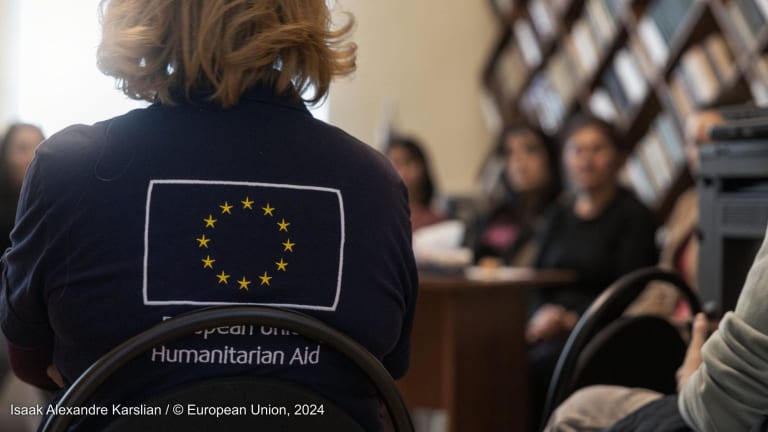
2014 is shaping up to be a momentous year in global development business. Last week, Devex President and Editor-in-Chief Raj Kumar made his predictions for global development business in 2014. According to Kumar, donor reform is likely to pick up steam this year even as pressure eases on foreign aid budgets.
Meanwhile, Michael Igoe, our correspondent in Washington, reports that as early as this month, we could see the launch of the U.S. Agency for International Development’s science, technology and innovation institute, known to be a “legacy item” for the agency’s administrator, Rajiv Shah.
And on the sidelines of the recently held European Development Days in Brussels, Devex Editor Rolf Rosenkranz learned that sometime in 2014, the European Union is expected to finalize a series of flagship aid initiatives designed to address cross-cutting development challenges.
Of course, in this fast-changing industry, there are as many unknowns as there are knowns in global development business heading into 2014. Here are five of the most pressing development business questions for this year.
Will Obama’s foreign aid initiatives have enough staying power?
During his historic visit to sub-Saharan Africa in June, U.S. President Barack Obama unveiled Power Africa, the latest in his marquee global development initiatives, which also include the Global Health Initiative, Feed the Future and the Global Climate Change Initiative. Amid murmurs of “initiative fatigue” in the U.S. aid community, few expect Obama to embark on any further major aid initiatives in his remaining three years in office.
Obama’s foreign aid initiatives — seen by many as ambitious in these times of austerity — have begun to yield promising if uneven results. In search of an enduring development legacy, administration officials are keen to press on. It is less clear, however, whether the rest of Washington, including a U.S. foreign aid bureaucracy historically resistant to change, shares the same level of commitment.
For now, interagency rivalries seem to have stalled GHI’s drive to streamline and synergize the U.S. global health regime. Meanwhile, Congress has dragged its feet on the Obama administration’s proposal to source U.S. food aid locally, potentially undercutting Feed the Future, considered to be the administration’s single most transformative aid initiative to date.
The looming 2014 Quadrennial Development and Diplomacy Review, the administration’s widely anticipated strategic document for its diplomatic and development efforts, could add momentum to Obama’s foreign aid initiatives. The 2010 QDDR is credited in some quarters with elevating then U.S. Secretary of State Hillary Clinton’s development priorities, including women’s rights and empowerment.
Will Abbott keep his promise to grow the Australian aid budget?
Shortly after taking office in September, the Abbott government signed off on the re-integration of the Australian Agency for International Development into the country’s foreign ministry. Four months on, there remains palpable anxiety in the Australian aid community about the re-integration, a move which Abbott’s conservative coalition had kept under wraps until after the election.
Unsurprisingly, many are now skeptical that the Abbott government will keep its 11th hour campaign pledge to grow the Australian aid budget through 2017, albeit much more modestly than under the previous Labor government. Sources close to the Abbott government have told Devex that they don’t anticipate a major U-turn from Canberra even as some aid groups are far less optimistic.
The Abbott government’s first federal budget — expected in May — should provide further clarity on its aid spending plans. Citing an uncertain fiscal outlook, the previous Labor government had deferred aid spending targets in its last two budgets, prompting much hand wringing from the then-conservative opposition. The Abbott government’s midyear fiscal outlook from last month, which revealed a further deterioration in the budgetary situation, suggests that it may well follow suit.
How far will the EU go with its differentiated aid policy?
After lengthy negotiations in Brussels, the European Union recently approved its 2014-2020 budget, which included a small increase in its development aid. Much like the United Kingdom — another major aid donor that has protected its aid spending despite budget pressures at home — the EU is nonetheless pressing ahead with plans to refocus its resources on poorer countries where it believes it can achieve the most impact.
Under the EU’s differentiated aid policy, which takes effect this year, upper middle-income countries will no longer be eligible for funding from the EU’s Development Cooperation Instrument, the main funding stream for EU aid to South Africa and countries in Latin America, Asia, Central Asia and the Gulf region. A handful of DCI partners — including Cuba and South Africa — are on track to be exempted from the differentiated aid policy.
Yet while a consensus in Brussels has emerged on applying the differentiated aid policy to the DCI, discussions are ongoing on how exactly the policy will be applied to the European Development Fund, the main funding stream for EU aid to African, Caribbean and Pacific countries. According to Mikaela Gavas, a research fellow at the Overseas Development Institute who has been following the discussions closely, Caribbean countries as well as Mauritius, Seychelles, Gabon, Botswana and Namibia are likely to see reductions in EU aid even as they remain eligible for EDF funding.
Will post-drawdown Afghanistan be safe enough for aid workers and organizations?
At a donors’ conference in the United Kingdom later this year, Western governments are expected to reaffirm their aid commitments to Afghanistan beyond the planned drawdown of NATO forces at the end of 2014. Even as they insist on greater transparency and accountability from Kabul, the international community is on track to meet its pledge of $16 billion in development assistance to Afghanistan from 2012 to 2015, according to the Afghan Ministry of Finance.
Afghanistan’s largest aid donor, the United States, has pledged to sustain current aid levels in Afghanistan through 2017 — no easy sell in Washington amid the steady stream of waste, fraud and abuse allegations implicating the U.S. foreign aid program in the country.
Yet even as Western governments seem determined to stay the course in their development engagement in Afghanistan, the planned NATO drawdown could lead to further deterioration in security conditions for many of the aid organizations which donors have come to rely upon to deliver assistance on the ground. In November, nine aid workers were killed in Oruzgan and Faryab provinces — the latest sign that aid workers are now being specifically targeted in the war-torn country. Months before, the International Rescue Committee had suspended operations in Afghanistan following the killing of five of its local staff members.
Will emerging donors press on despite slowing growth?
As Western donors pulled back on aid spending in the aftermath of the global economic downturn, many in the development community have been increasingly looking to the BRIC countries and other emerging economies to help fill the gap. Eager to bolster their global standing, emerging donors have quintupled their foreign aid flows over the past five years.
Against the backdrop of recent slowing growth, however, there are signs that emerging economies may be beginning to roll back their donor ambitions. Most recently, South Korea revealed in December that it may not meet its target to provide 0.25 percent of gross national income to foreign aid by 2015. Despite repeated pronouncements over the years, plans for fully fledged aid agencies in India, South Africa and Russia have been put on the backburner. The BRICS development bank — touted by the BRICS countries as a rival to the World Bank — has also yet to materialize.
Further, 2014 is an election year in three of the major emerging donors — India, South Africa and Brazil. Amid growing political unease, these countries will be under pressure to ratchet up domestic spending, which arguably does not bode well for their foreign aid programs in the short-term.
Join the Devex community and gain access to more in-depth analysis, breaking news and business advice — and a host of other services — on international development, humanitarian aid and global health.








